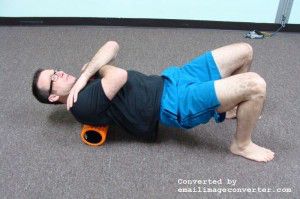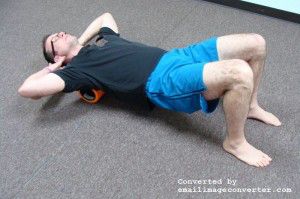Extreme pain and debilitating injury
Every single week I have several new clients come in to see me because they are in a great deal of pain. A handful have been dealing with it for a matter of a few weeks and have tried a couple different home remedies with unsatisfying results. But by far most of my clientele have suffered for multiple months or many years. They’ve gone to doctors and physical therapists, they’ve undergone surgeries, all with very little or even zero results. Pain has taken over much of their lives.
The most common injuries that I see in any given week are plantar fasciitis, sciatic pain, and pains at the top of foot, achilles, shins, knees, low back, shoulders and neck. For some the problem is structural in nature, which means that I’m ultimately limited in how much I can help beyond providing them temporary pain relief. But for the vast majority of my clients, even though each of these injuries are located in different parts of the body and have scary sounding diagnostic names, the root cause tends to be the same: poor postural (movement) habits that have caused dysfunction in the fascial tissue. These are habits that, with work, can be changed. There is hope that with time, effort, and help you can greatly minimize the chronic pain you are currently suffering from and prevent or quickly recover from future injuries.
Posture is not what you think it is
Ultimately, pain has everything to do with movement. Healthy movement requires joint stability. Posture is your body’s ability to, through stabilization, hold everything together as you move. Yet posture is anything but a static. Your posture is active throughout every movement, whether you are standing, sitting, lying down, walking, running, squatting, jumping, climbing and so on. When you develop poor postural habits (for example: dysfunctional walking or running gait) your postural muscles will fail to properly stabilize the joints, causing stress and damage to the fascial and joint systems. The two most common areas of poor postural habits that I see come from sitting for long hours every day and poor walking and running gait. I have written a series of articles on posture (part 1 and part 2) with corrective exercises to help establish a healthy stable posture for the feet, hips and shoulders.
What is Fascia?
Fascia is a continuous web of connective tissue that wraps around muscles, tendons, ligaments, bones, and organs. Fascia, which acts kind of like plastic wrap, binds these structures together creating a three-dimensional matrix connecting everything inside of you from the top of your head to the tips of your toes. Your muscles are wrapped tightly in fascia and it plays a fundamental role in your movement, as well as in your circulatory and neurological systems. Your whole body is totally interconnected by your fascia. Movements ruled by poor postural habits cause adhesions or tightness to develop in the fascia. Adhesions lead to loss of or reduction in range of motion, poor tissue health, inflammation, joint friction, and ultimately pain and injury. Due to the interconnected nature of fascia, tightness in one area of your body is likely the direct cause of pain in a completely different area. As the fascial tissue tightens, it pulls throughout the body causing pain somewhere else. This is called referred pain. (Read more about fascia and its relationship to pain here.)
Establishing healthy postural habits is by far the best way to prevent long term pain and injury. Below I outline my protocol, in order of importance, for treating and preventing chronic pain and injury, breaking down poor postural habits, increasing functional range of motion, re-establishing a stable posture, and developing healthy functional movement.
Professional Fascial Massage
The goal of deep tissue massage therapy is to break down the adhesions in the fascial tissue. Adhesions restrict the flow of blood, oxygen and waste products; limit joint range of motion; and are the primary cause of most soft-tissue pain and discomfort. I recommend finding a qualified and experienced massage therapist who specializes in fascial massage and pain relief. I highly encourage you to interview several therapists.
I have seen tremendous results using deep tissue massage with clients dealing with painful injuries such as plantar fasciitis, knee pain, sciatic pain, and low back pain. Most of my clients have a significant reduction of pain in the first or second session and are pain free within four to eight sessions.
Self-Massage
In my opinion, a foam roller is the cheapest most effective tool for your long term fitness and health. Self-massage is by far one of the best practices you can add into your daily or weekly routine. By performing self-massage techniques using a foam roller or ball, you can break down fascial adhesions, increase functional joint range of motion, reduce pain and prevent injury. Integrating weekly self-massage will change your life. I advise all of my clients to use self-massage to treat all the the common injuries I listed earlier with great results. The combination of professional massage and self-massage are two powerful tools in recovering from and preventing pain and injury.
Self-massage is also an amazing way to speed up the recovery process between workouts, allowing you to train harder and smarter. Below you will find pictures with descriptions of self-massage techniques.
Flexibility
This comes from a combination of self-massage and stretching. As you break down fascial adhesions that have restricted your joint mobility, you need full body stretching to re-establish functional range of motion. The goal is to fully open up the ankles, hips and shoulders.
Corrective Exercise
Now that you are moving towards a full range of motion you’ll be using your muscles in new and old ways - some that your body has not used in a long time. It is important to establish postural stability and control to prevent injury at this point. I have demonstrated a series of corrective exercises to help establish a healthy stable posture for the feet, hips and shoulders on my blog.
Barefoot Movement
Barefoot movement falls into the category of corrective exercise. Walking and running gait dysfunction are one of the primary causes of poor postural habits that lead to chronic pain and injury. With every single client I treat, most pain patterns can be traced to the feet. Quite often it has to do with the shoes they wear.
Feet are the foundation of posture. A strong foot is the base support structure for a strong healthy body. A weak foot is an unstable foundation affecting the posture from head to toe. You cannot build a strong stable structure over an unstable foundation. It would be like attempting to build a house on top of sand. It doesn’t take very long before the entire structure collapses.
Shoes change the way you walk, period. Some more than others. Obviously, shoes with a stable structural arch support, cushion, and a high heel wedge significantly change the way your foot strikes the ground. But even minimalist shoes have an impact on your gait, albeit to a much lesser extent. (Read more about how shoes affect your gait here.)
Freeing your feet to stabilize your body in all movement is vital to establishing strong healthy postural habits. And I am not talking about barefoot running alone. Barefoot walking and running are a great form of healthy exercise, but if that is the only movement you are doing barefoot, you are still asking for problems. Walking and running are linear and repetitive, meaning you are doing the same motion over and over. Repetition is a precursor to injury. The key to healthy functional movement and postural health is barefoot movement, not just barefoot running or walking. It is using your feet to move in every direction your body is designed to move.
Functional Movement
Sitting is another of the primary causes of the poor postural habits that lead to pain and injury. Unfortunately, if you can’t quit your job, you will likely continue to sit for long periods of time throughout the week. This makes the need for good healthy fun functional movement really important. Your body needs it to compensate for sitting all day, and it needs it every day.
Functional movement is what happens when you use your body to meet all of its designed purposes: flexing, extending, pulling, pushing, rotating, changing directions, running, walking, jumping, sprinting and climbing at all the varying directions and speeds it is capable of, from slow and steady to short, fast and powerful. If you are designed to do it, then use your body to do it. If you don’t, you will eventually lose your ability to do it. This leads to a higher risk of chronic pain and injury.
Since movement, especially walking and running, are a leading area of postural dysfunction, it is important to focus on proper mechanics. Shoes have been placed on our feet from the moment we started walking. From our very first steps, shoes have affected our foot and leg musculature preventing natural gait and postural development. At this point, you can assume that your body does not inherently know how to walk or run properly. I suggest finding a good barefoot/minimalist running coach to teach proper gait mechanics and a functional movement coach or personal trainer to instruct you on posture and form. This will save you from a lifetime of ongoing debilitating pain and injury.
Self Massage Techniques
Self-massage is the most powerful tool available for your long term health. It is very simple to learn, can be done daily and is extremely effective. By teaching foam roller techniques, I have helped many clients through painful running injuries without even touching them. On a personal note, I attribute the fact that I can still run after five knee surgeries (3 reconstructions) to foam roller therapy.
To perform self-massage you will need a foam roller and/or a small ball (such as a golf ball, lacrosse ball, or softball). I recommend either a black foam roller from www.OPTP.com or The Grid from Trigger Point Therapy.
The first couple of weeks using a foam roller for self-massage will be intense. It gets better and it is worth it. By the end of the second week, it won’t hurt as much and will actually begin to feel good. Plus you will start to feel a difference in how you move.
Following the pictures below, place your body weight on the foam roller or ball over taut bands of muscle tissue. For the best results, begin near the center of the body and slowly work towards the extremities.
When you find a painful spot, stop and visualize the soft tissue as melting butter and the foam roller or ball as a hot knife. Allow pressure into the tissue and within 30-60 seconds you will notice a significant reduction in pain. Once the pain reduces (20-30%), move on to the next painful spot and repeat.
Spend between 3-5 minutes on each region of the body. It is very important that you spend an equal amount of time on both sides and that you work through each of the areas listed to gain the most out of self-massage.
Arch
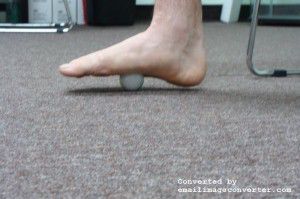
Calves
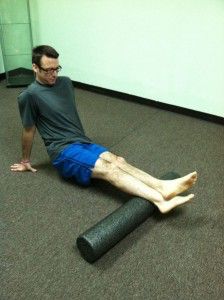
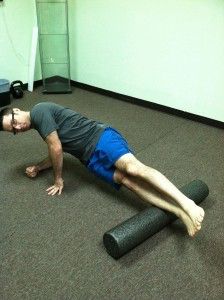
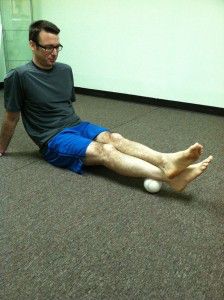
Hips
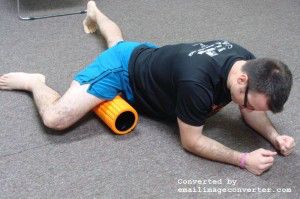
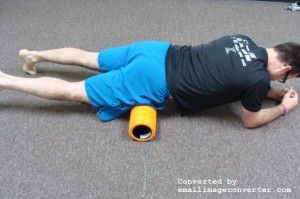
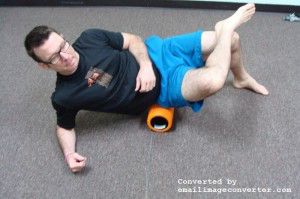
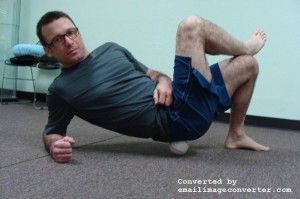
Lats and Teres Minor
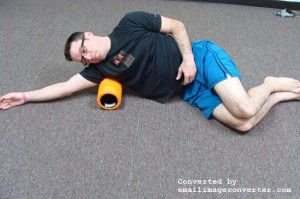
Upper Back
